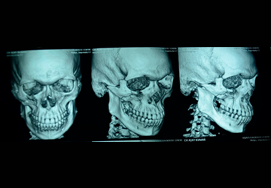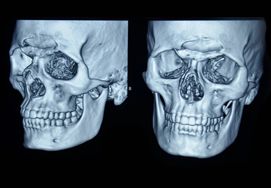Naso Ethmoidal Fractures
Recommended if you have nasal deformities due to fracture, nasal and forehead swelling and lacerations, diplopia, telecanthus, and cerebrospinal fluid (CSF) rhinorrhea

-
What are Nasal Bone fractures and
Complex Naso ethmoidal fractures? - What are the types of nasoethmoidal fractures?
-
What are the types of the surgeries for
naso ethmoidal fractures? - Which individuals are eligible for the surgery?
- Which individuals are not eligible for the surgery?
- How should I prepare for the surgery?
- What is the aftercare of the surgery?
- What are the complications of the surgery?
What are Nasal Bone fractures and Complex Naso ethmoidal fractures?
Nasal bone fractures are one among the most common facial bone fractures. They can occur in isolation or can accompany other facial fractures. They require to be managed properly to prevent functional and aesthetic deformity later.
Nasoethmoid fractures typically result from a forceful blow to the central aspect of the mid face. Motor vehicle accidents are the most common source of injury, followed by assault.
The nasoorbitoethmoid (NOE) complex is the confluence of the frontal sinus, ethmoid sinuses, anterior cranial fossa, orbits, frontal bone, and nasal bones. The intricate anatomy of this area makes NOE injuries one of the most challenging areas of facial reconstruction. Inadequately repaired NOE fractures often result in secondary deformities that are extremely difficult (or impossible) to correct
Naso-orbito-ethmoid (NOE) fractures are usually associated with significant cosmetic and functional sequelae. Expeditious definitive therapy is needed to best correct these problems. Thus, most of these fractures should be reduced and repaired surgically.
Long term sequelae of untreated or inadequately treated NOE fractures include blindness, telecanthus, enophthalmos, midface retrusion, cerebral spinal fluid (CSF) fistula, anosmia, epiphora, sinusitis, and nasal deformity. Accurate diagnosis and prompt surgical treatment of NOE fractures are critical to avoid complications and to obtain an aesthetic surgical result
What are the types of nasoethmoidal fractures?
Complex Nasoethmoidal Fractures are also known as Orbitoethmoid or Naso-orbitoethmoid (NOE) fractures which involve the central upper midface. These fractures are mainly caused by a high-impact force applied anteriorly to the nose and transmitted posteriorly through the ethmoid bone.
Naso ethmoid fractures are classified into three types they are type I, type II, and type III.
Type I: It involves a single, noncomminuted, central fragment without medial canthal tendon disruption.
Type II: It involves comminution of the central fragment without medial canthal tendon disruption.
Type III: It results in severe central fragment comminution with medial canthal tendon disruption.
The goals of NOE fracture surgery include the protection of orbital and intracranial contents, prevention of early and late complications, and restoration of aesthetic facial contour.
What are the types of the surgeries for naso ethmoidal fractures?
The approaches for treatment of naso ethmoidal fracture surgery include:
- Coronal incision provides your surgeon a best access to the sinus and the frontal bone. This type of incision produces a most desired outcome. This technique allows the exposure of frontal bone, nasal bones, superior orbital rims, orbital roof, and frontomaxillary buttress.
- Subciliary incision allows the access to inferior orbital rims where an orbital floor, a portion of the medial orbital wall, the frontomaxillary buttress, and lateral nasal bones are exposed.
- Though existing laceration or skin avulsion injury – when there is a direct injury Then it may be used. To gain access to the fracture site.
Which individuals are eligible for the surgery?
Your surgeon may recommend you the surgery if you have,
- nasal deformities due to fracture
- nasal and forehead swelling and lacerations
- Diplopia
- telecanthus
- cerebrospinal fluid (CSF) rhinorrhea
Which individuals are not eligible for the surgery?
- Patients who are having other life threatening injuries. Patient who have severe head injury and are unlikely to survive
- Specific contraindications include optic nerve injury and globe injury (eg, hyphema, rupture, laceration). In these patients, swelling from osseous manipulation may exacerbate damage to the eye. These issues must be addressed and stabilized prior to attempting to repair the NOE fracture
- Persons who have bleeding tendency (uncontrolled)
- Diabetes (uncontrolled)
- Blood pressure (uncontrolled)
- Patients who do not have realistic expectations from the surgery
How should I prepare for the surgery?
Before the surgery you should:
- your doctor will explain in detail about the procedure to you
- Get your blood work, radiographs, Scans done.
- Anaesthetic fitness done
- Should be nil by mouth for at least 6hours
- Informed consent has to be signed.
- Blood sugars and blood pressure should be under control.
What is the aftercare of the surgery?
Your surgeon will advise you certain instructions for fast recovery that include the following:
- Drink liquids and eat only soft foods and avoid taking hot liquids and hot foods.
- Avoid putting pressure on your nose.
- Do not bend your head below the heart level.
- Keep your mouth clean
- Sneeze by opening your mouth
- Apply ice to the nasal area
- Avoid smoking and drinking for ten days
What are the complications of the surgery?
Complications of nasal reconstructive surgery:
- Minor bleeding
- Hematoma
- Bacterial infection
- Injury to nerves
- Bruising and swelling
- Altered sense of smell
- Graft infection
- Altered breathing
- Worsen cerebrospinal fluid leak










